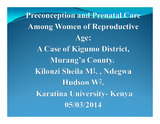PURE AND APPLIED SCIENCE FOR VISION 2030
Abstract
Pure and applied science, in its broadest sense, means much more than
simply being able to read, understand and write about pure and applied
science and technology, however important these are. This also includes
the ability to apply scientific and technological concepts and process skills
to the life, work and culture of one's own society. This paper aims at
simplifying the concepts pure and applied science for utility by the
population towards technological development benefits and challenges.
The understanding of the concepts will lead to policies that reinforce
investment and motivation in enrolment in pure science courses at various
levels of Education. Training in pure and applied sciences gives a strong
foundation to enhance literacy in technological advancement. This will
enhance developing of career and skills relevant to the attainment of Kenya
Vision, 2030. A literate population will manage its destiny better and
harness resources at their disposal in a highly technological world.
Understanding of basic scientific principles and laws will lead to respecting
simple protocol processes e.g. curing in construction, basic health
principles, etc. The population equipped with knowledge of pure and
applied science will be sensitive to cause of accidents, wastage, efficiency,
and conflicts with nature, technology and self. In bringing out the
differences between pure and applied science in research and
development, a few of the scientist and their discoveries will be discussed. A discussion on applied science and Technology to eliminate confusion of
concepts is worth venturing into. Key words: Pure and applied science, Utility, Enrolment, Literacy,
Scientific principle, Technology

